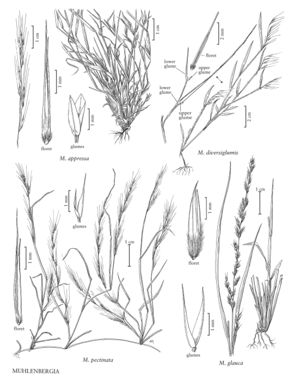Difference between revisions of "Muhlenbergia glauca"
FNA>Volume Importer |
FNA>Volume Importer |
||
| Line 17: | Line 17: | ||
-->{{Treatment/Body | -->{{Treatment/Body | ||
|distribution=Calif.;Ariz.;N.Mex.;Tex. | |distribution=Calif.;Ariz.;N.Mex.;Tex. | ||
| − | |discussion=<p>Muhlenbergia glauca grows on calcareous rocky slopes, cliffs, canyon walls, table rocks, and volcanic rock outcrops, at elevations of 1200-2780 m. Its range extends from the southwestern United States to central Mexico. M. glauca resembles M. polycaulis, but differs in its shorter lemma awns and strongly rhizomatous habit.</p> | + | |discussion=<p><i>Muhlenbergia glauca</i> grows on calcareous rocky slopes, cliffs, canyon walls, table rocks, and volcanic rock outcrops, at elevations of 1200-2780 m. Its range extends from the southwestern United States to central Mexico. <i>M. glauca</i> resembles <i>M. polycaulis</i>, but differs in its shorter lemma awns and strongly rhizomatous habit.</p> |
|tables= | |tables= | ||
|references= | |references= | ||
| Line 26: | Line 26: | ||
-->{{#Taxon: | -->{{#Taxon: | ||
name=Muhlenbergia glauca | name=Muhlenbergia glauca | ||
| − | |||
|authority=(Nees) B.D. Jacks. | |authority=(Nees) B.D. Jacks. | ||
|rank=species | |rank=species | ||
| Line 33: | Line 32: | ||
|basionyms= | |basionyms= | ||
|family=Poaceae | |family=Poaceae | ||
| − | |illustrator=Linda A. Vorobik | + | |illustrator=Linda A. Vorobik;Annaliese Miller |
| + | |illustration copyright=Utah State University | ||
|distribution=Calif.;Ariz.;N.Mex.;Tex. | |distribution=Calif.;Ariz.;N.Mex.;Tex. | ||
|reference=None | |reference=None | ||
| Line 39: | Line 39: | ||
|publication year= | |publication year= | ||
|special status= | |special status= | ||
| − | |source xml=https:// | + | |source xml=https://jpend@bitbucket.org/aafc-mbb/fna-data-curation.git/src/f50eec43f223ca0e34566be0b046453a0960e173/coarse_grained_fna_xml/V25/V25_731.xml |
|subfamily=Poaceae subfam. Chloridoideae | |subfamily=Poaceae subfam. Chloridoideae | ||
|tribe=Poaceae tribe Cynodonteae | |tribe=Poaceae tribe Cynodonteae | ||
Revision as of 21:37, 16 December 2019
Plants perennial; rhizomatous, rhizomes slender, well-developed. Culms 25-60 cm tall, 1-2 mm thick, often decumbent, sometimes erect; internodes mostly scabrous, retrorsely hispidulous below the nodes. Sheaths longer than the internodes, scabridulous; ligules 0.5-2 mm, truncate to obtuse, erose or lacerate; blades 4-12 cm long, 1-2.6 mm wide, flat to involute distally, not arcuate, scabrous abaxially, hirsute or scabrous adaxially. Panicles 4-12(17) cm long, 0.3-2.4 cm wide, contracted, interrupted below; branches 0.3-3 cm, usually appressed, occasionally diverging up to 30° from the rachises; pedicels 0.1-1.2 mm, scabrous to hirsute. Spikelets 2.4-3.5 mm. Glumes equal, 1.5-3.5 mm, 1-veined, veins scabrous, apices acute or acuminate, usually awned, awns, if present, to 1.5 mm; lemmas 2.4-3.4 mm, elliptic, pubescent on the lower the 1/2 of the midveins and margins, hairs to 0.6 mm, tawny, apices acuminate to acute, awned, awns 0.1-3(5) mm; paleas 2.2-3.4 mm, elliptic, intercostal region pubescent on the lower 1/2, apices acuminate to acute; anthers 1.8-2.4 mm, orange. Caryopses 1.7-2 mm, fusiform, brownish. 2n = 60.
Distribution
Calif., Ariz., N.Mex., Tex.
Discussion
Muhlenbergia glauca grows on calcareous rocky slopes, cliffs, canyon walls, table rocks, and volcanic rock outcrops, at elevations of 1200-2780 m. Its range extends from the southwestern United States to central Mexico. M. glauca resembles M. polycaulis, but differs in its shorter lemma awns and strongly rhizomatous habit.
Selected References
None.
